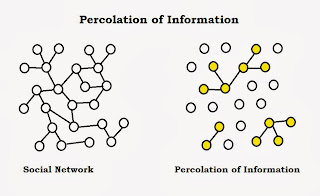Word of mouth fosters social learning about issues,
products, and opportunities. Friends
that act and think alike often create clusters and these clusters can influence
the purchasing choices as well as the decisions members make. Economists often have
difficulty formulating how social networks formulate and influence people’s
impressions of products and services. Research by Arthur Campbell (2013) sheds
light on how word of mouth in social networks influences perception of value.
When individuals are interested in a concept or
product they are naturally more willing to engage in word of mouth. Generally,
as a product’s price is lower it raises the interest level and the potential
discussion of the product leading to more word of mouth activity. It is this
interaction that brings to the forefront ideas, concepts, and discussions on
products that are settled within a group.
One of the difficult aspects of understanding social
networks and diffusion is the complexity of the system. Despite this complexity, it is known that as
activity increases information is spread out to a wider group of people thereby
creating more advertisement. The complexity has made chasing down the pieces of
information and how they spread difficult.
Yet through models it is possible to understand the process of
information peculation in an imperfect manner.
One potential way to look at how information is
transferred is in a formula:
Ξ ⊆ { ( i, j ) | i
≠ j ∈ N }
Everyone is connected to a social network = ( N, Ξ )
Nodes = n
Relationship between
individuals i and j = ( i, j ) ∈ Ξ
The probability of a
person i passing out information = ν ( θ i , P )
The model is
undirected in the sense that information can percolate anywhere. All of the
consumers are uninformed and the chance that people will buy a product is based
on a percentage of the amount of people that become informed. The timing of the
model can be seen as-
(i) Each
person in the population becomes informed with independent probability
ε
≈ 0 (later they may also become informed through advertising).
(ii) Informed
individuals tell all their friends about the product through WOM
with
probability ν ( θ i ,
P ) and purchase the product if θ
i ≥ P.
(iii) Step
2 is repeated for newly informed consumers until there are no more
consumers
being informed.
The model is
impacted by availability of competitive products, information, pricing, and a
whole array of other factors that go into the process. When a competitive product
or alternative explanation is not available it will naturally impact the
options and choices within the social network. Likewise, if more information
about a product is available it can impact the eventual agreement and promotion
of such products with the group.
When companies
advertise they often seek to hit specific components within the social
networks. Those persons that are more socially connected will likely spread
their impressions of the products or services more widely. This is a simple
function of connectivity to other members and the ability to be an influencer
within the network. Most of us would recognize the superstar promoters of
products and services.
The paper finds a number of interesting associations
of price, information/advertisement, and the connections of the network.
Generally, as information passes through the network in “buzz” and in tight
clusters the prices remain higher. However, if the information passes more
slowly or in dispersed networks the prices will remain lower. Word of mouth is
a medium that could be positive or negative in its impact.
Thinking about how information moves through
networks it is important to remember that members will engage in social
learning based upon how they evaluate the products against each other. If
popular opinion is that the product is not desirable it will hamper others from
buying that product. It means that we are social creatures that evaluate the
work of products based upon how others view those products within our networks.
If their feedback is negative we will come to the conclusion that a product is
less worthy.
Such a model does not necessarily need to work with
products alone but could be used within an organizational setting to understand
how information moves quickly among members. Each person who obtains the
information, evaluates it based upon their social schemata, and then promotes
that viewpoint to others. If the information is of significant worth it will
move faster while if it is of little worth it will spread slower. One must have an internal gauge to think
independently from their clustered networks and this is unlikely for the majority of the population as they are connected to clusters who think alike. Thus, our opinions are often a direct result
of our social networks.
Campbell, A. (2013). Word-of-mouth communication and
percolation in social networks. American
Economic Review, 103 (6).

No comments:
Post a Comment